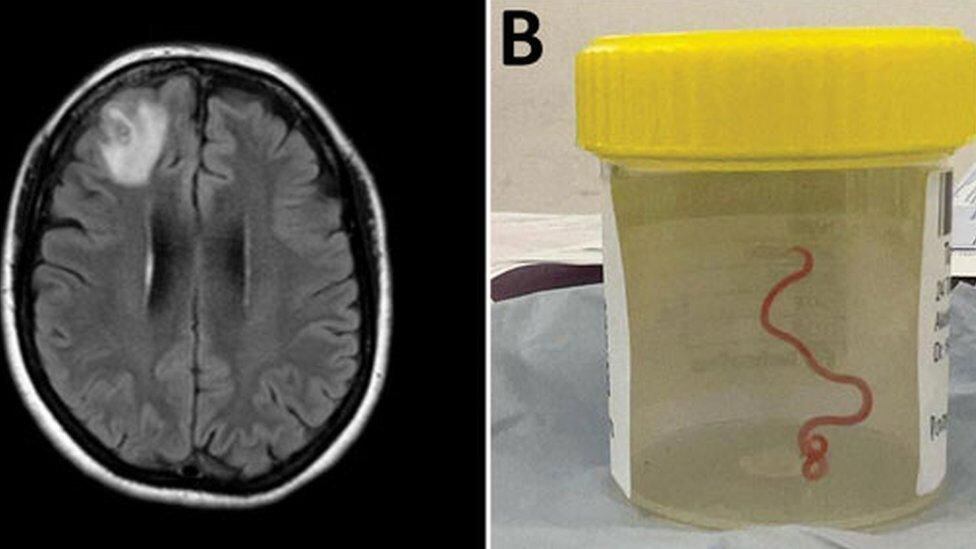In a case never before documented in the world, scientists reported finding a live 8cm worm in the brain of a woman in Australia.
The “rope-like structure” was removed from the patient’s injured frontal lobe during surgery in Canberra last year.
LOOK: Héctor Garibay, the Bolivian taxi driver who won the Mexico City Marathon with a record time
“It was definitely not what we expected. Everyone was in shock,” said Dr. Hari Priya Bandi, the neurosurgeon who operated on the patient.
The 64-year-old woman suffered from what doctors called an “unusual constellation of symptoms”: stomach pain, coughing and night sweats, which progressed into increasing memory problems and depression.
The woman was admitted to hospital at the end of January 2021, and a subsequent scan revealed “an atypical lesion in the right frontal lobe of the brain.”
But the cause of his disorder was only revealed with Dr. Bandi’s scalpel. during a biopsy in June 2022.
Doctors said the red parasite may have been alive in the woman’s brain for up to two months.
The woman, who lived near a lake area in the state of New South Wales, is recovering well.
This is believed to be the first documented case. on invasion and development of larvae in the human brainthe researchers reported in a study in the journal Emerging Infectious Diseases.
“I pulled it out…and it was moving happily”
The neurosurgeon who found the worm described how she had just begun to touch a part of the brain that had appeared strange during the scans, when she felt the worm.
“I thought, oh my gosh, this feels so weird, this is totally abnormal,” said Dr. Bandi.
“And then I could really feel something, and I took my tweezers and pulled it out and I was like, ‘God! What’s that? It is moving!”.
“Everyone was in shock. And the worm we found was moving happily, quite vigorously, out of the brain,” he said.
He then consulted his colleague Sanjaya Senanayake, an infectious disease specialist, about what they should do.
“Everyone in that operating room had the shock of their life when [la cirujana] took a pair of tweezers to feel for an abnormality and the abnormality turned out to be a live, light red, 8cm worm wriggling,” said Dr Sanjaya Senanayake, an infectious disease specialist at Canberra Hospital.
“Even if the yuck factor is removed, this is a new infection never before documented in a human.”
Investigators warn that the case highlights the growing danger that disease and infection are transmitted from animals to people.
The roundworm nematode Ophidascaris robertsi is common in carpet pythons, non-venomous snakes found throughout much of Australia.
Scientists say the woman most likely contracted the parasite after collecting a native weed type, greens of Warrigal, by a lake near where he lived.

Writing in the journal Emerging Infectious Diseases, Mehrab Hossain, an Australian parasitology expert, said he suspects the woman became an “accidental host” after using the collected plants, contaminated by python feces and parasite eggs, for cooking.
“Invasion of the brain by Ophidascaris larvae has not been previously reported,” writes Dr. Hossain.
“The growth of the third instar larva in the human host is remarkable, given that previous experimental studies have not demonstrated larval development in domesticated animals, such as sheep, dogs, and cats.”
Dr Senanayake, who is also an associate professor of medicine at the Australian National University (ANU), told the BBC that the case is a warning.
The ANU team reported that 30 new types of infections have emerged in the past 30 years.
Three quarters of these are zoonotic: infectious diseases that have jumped from animals to humans.
“This simply shows that as the human population grows, we get closer and closer to each other. we invade more and more the habitats of animals. This is a problem we see over and over again, whether it’s the Nipah virus that jumped from wild bats to domestic pigs and then to people, or whether it’s a coronavirus, like Sars or Mers, that has jumped from bats to possibly a secondary animal and then to humans,” says the researcher.
“Even though covid is slowly fading, it’s really important that epidemiologists…and governments, make sure they have good infectious disease surveillance,” he adds.
Source: Elcomercio
I am Jack Morton and I work in 24 News Recorder. I mostly cover world news and I have also authored 24 news recorder. I find this work highly interesting and it allows me to keep up with current events happening around the world.

:quality(75)/cloudfront-us-east-1.images.arcpublishing.com/elcomercio/5SBVZEXSDFEG5EKWHYDVAIT5NE.jpg)


:quality(75)/cloudfront-us-east-1.images.arcpublishing.com/elcomercio/NLALQHZCRFA47IE7WOMGEKL4VQ.jpg)
:quality(75)/cloudfront-us-east-1.images.arcpublishing.com/elcomercio/Q2EOPBKOSVG3BDSDJRSUBRXUZY.jpg)

